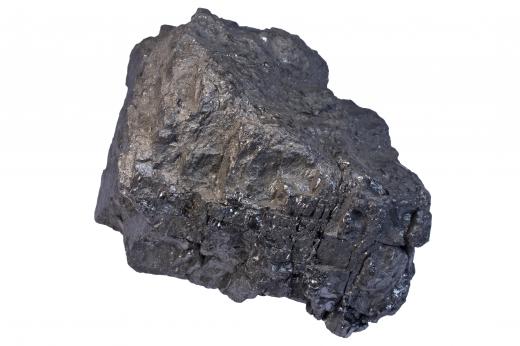What is Coal Liquefaction?
 Michael Anissimov
Michael Anissimov
Coal liquefaction is a process used to turn coal, a solid fuel, into a substitute for liquid fuels such as diesel and gasoline. This process has historically been used in countries without a secure supply of crude oil, such as Germany and South Africa. The technology used in the process is quite old, and was first implemented during the 19th century to provide gas for indoor lighting. Coal liquefaction may be used in the future to produce oil for transportation and heating, in case crude oil supplies are ever disrupted.
Coal liquefaction takes place in two main stages; coal gasification, and gas-to-liquid (GTL). During coal gasification, air and steam are added to raw coal, which is heated to several hundred degrees Fahrenheit (Celsius). The carbon in the coal reacts with the oxygen and water, producing other gases such as carbon dioxide, carbon monoxide, hydrogen, and methane. The carbon dioxide is waste and can be vented to the atmosphere; the other gases can be burned or sent on for further processing. During the 19th century, before electric lighting, this gas was burned to provide a light source for buildings and streets.

The second stage is also known as the Fischer-Tropsch process. Once the coal gas has been filtered and processed, water or carbon dioxide can be added to adjust the ratio between carbon monoxide and hydrogen. The hot gas is then passed over a catalyst, which causes the carbon monoxide and hydrogen to condense into long hydrocarbon chains and water. The hydrocarbon chains can be used as a substitute for oil products such as gasoline, kerosene, and heating oil, while the water can be recycled and used as steam in the beginning of the process.

Coal liquefaction is generally more expensive than producing fuel from crude oil, but it can become economical if crude oil is scarce or unavailable. It was employed during WWII by the German Army, which had a large supply of coal but little oil, to run tanks and other war machines. Later, during apartheid in South Africa, coal liquefaction helped to make up for the loss of crude oil due to sanctions. In case of a major disruption in crude oil supply, coal liquefaction plants can be brought online fairly quickly, due to the simplicity of the technology and the high availability of raw coal.
AS FEATURED ON:
AS FEATURED ON:












Discussion Comments
There is an economical process available that can process waste coal to diesel fuel that will be available this spring. the system can produce diesel fuel for as little as $.25 a gallon.
Why are Coal companies not pushing making oil and gas from coal?
Post your comments